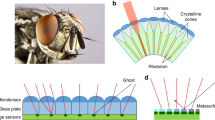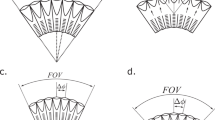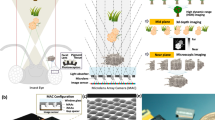Abstract
In most apposition compound eyes there are two components to the optical system of the ommatidium1,2, the cornea and the crystalline cone. The focusing power of the cornea is well documented3,4 whereas the crystalline cone is usually regarded as a mere optical spacer5,6; consequently, the ommatidial optics will consist of a simple focusing lens. To the contrary, we now demonstrate the existence of a complete afocal telescope in each ommatidium of butterfly apposition eyes. The optical system is an extreme variant of that found in refracting superposition eyes, thereby providing a connection between butterflies and moths.
This is a preview of subscription content, access via your institution
Access options
Subscribe to this journal
Receive 51 print issues and online access
$199.00 per year
only $3.90 per issue
Buy this article
- Purchase on Springer Link
- Instant access to full article PDF
Prices may be subject to local taxes which are calculated during checkout
Similar content being viewed by others
References
Ribi, W. A. Cell Tissue Res. 191, 57–73 (1978).
Yagi, N. & Koyama, N. The Compound Eye of Lepidoptera (Shinkyo, Tokyo, 1963).
Varela, F. G. & Wiitanen, W. J. gen. Physiol. 55, 336–358 (1970).
McIntyre, P. & Kirschfeld, K. J. comp. Physiol. 146, 493–500 (1982).
Snyder, A. W. in Photoreceptor Optics (eds Snyder, A. W. & Menzel, R.) 38–55 (Springer, Berlin, 1975).
Pask, C. & Barrell, K. F. Biol. Cybernet. 36, 1–8 (1980).
Nilsson, D.-E. Nature 302, 818–821 (1983).
Romeis, B. Mikroskopische Technik (Oldenbourg, Munich, 1968).
Jenkins, F. A. & White, H. E. Fundamentals of Optics (McGraw-Hill, New York, 1976).
Miller, W. H. & Bernard, G. D. J. Ultrastruct. Res. 24, 286–294 (1968).
Land, M. F. Prog. Biophys. molec. Biol. 24, 75–106 (1972).
Stavenga, D. G. in Handbook of Sensory Physiology, Vol 7/6A (ed. Autrum, H.) 357–439 (Springer, Berlin, 1979).
Snyder, A. W. & Love, J. D. Optical Waveguide Theory (Chapman & Hall, London, 1983).
Kapany, N. S. & Burke, J. J. Optical Waveguides (Academic, New York, 1972).
Horowitz, B. R. in Vertebrate Photoreceptor Optics (eds Enoch, J. M. & Tobey, F. L. Jr) 219–300 (Springer, Berlin, 1981).
McIntyre, P. & Caveney, S. J. comp. Physiol. (in the press).
Author information
Authors and Affiliations
Rights and permissions
About this article
Cite this article
Nilsson, DE., Land, M. & Howard, J. Afocal apposition optics in butterfly eyes. Nature 312, 561–563 (1984). https://doi.org/10.1038/312561a0
Received:
Accepted:
Issue Date:
DOI: https://doi.org/10.1038/312561a0
This article is cited by
-
Mike Land: a personal remembrance
Journal of Comparative Physiology A (2022)
-
Evolutionary constraints on flicker fusion frequency in Lepidoptera
Journal of Comparative Physiology A (2020)
-
Absorption-assisted mode transformation in butterfly compound eyes
Scientific Reports (2014)
-
The bright zone, a specialized dorsal eye region in the male blowflyChrysomyia megacephala
Journal of Comparative Physiology A (1989)
-
A new type of imaging optics in compound eyes
Nature (1988)
Comments
By submitting a comment you agree to abide by our Terms and Community Guidelines. If you find something abusive or that does not comply with our terms or guidelines please flag it as inappropriate.



